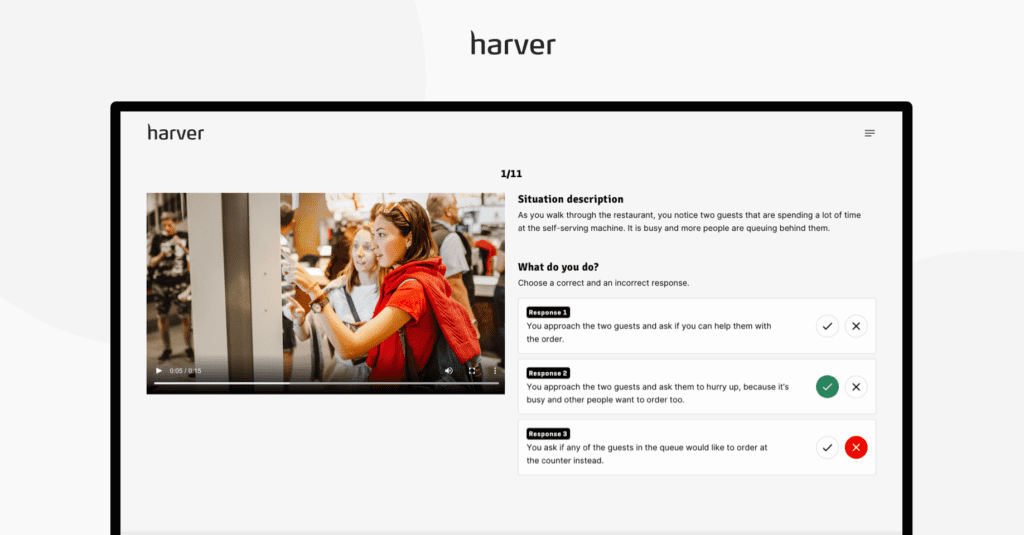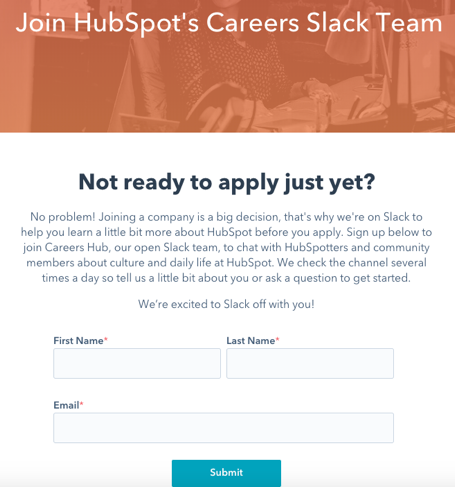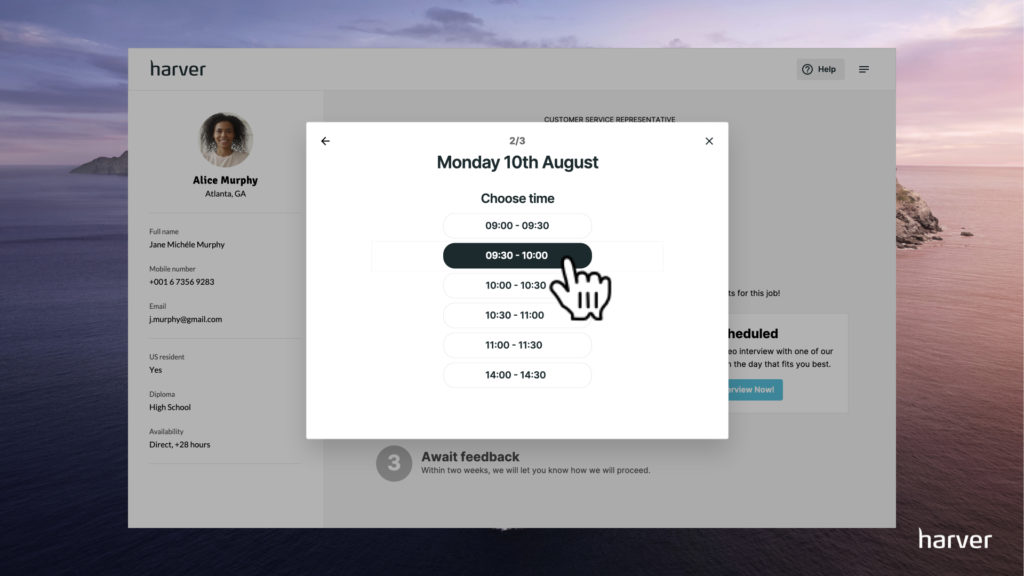Recruitment has turned into a two-way street, and you can’t afford to ignore candidate experience anymore. As much as you’re looking for a seamless fit for your own company, job applicants are also on the lookout for organizations that fulfill their requirements and match their own values.
Candidates are far more choosy and looking to find a match that’s mutually beneficial.
What does this mean for you as an employer? When you’re competing to land the very best talent out there, there’s no room for things like delays, frustrations, and lackluster hiring processes. The experience of your candidates—whether they’re eventually hired or not—contributes to your overall reputation as well as how your entire culture is perceived.
So let’s take a look at 18 tactics can you use to improve your hiring process and ensure an engaging applicant experience.
What’s in?
1. Add situational judgement tests
A great way to improve on your candidate experience is adding interactive Situational Judgement Tests – or SJT’s – to your hiring cycle. As the name suggests, an SJT shows the applicant a situation that might occur on the job and assesses his/her response to said situation.

Combining these SJT’s with video is where the real magic happens. You give the candidate an idea of what the job is really like so they can decide whether or not it’s what they’re looking for. And you get data on how this person handles certain situations.
To learn more about SJTs, check out the dedicated page below.
2. Streamline your application process
Of course, candidates are eager and willing to work hard on the job. The application, however? That shouldn’t involve a ton of unnecessary blood sweat and tears. Measure and test what you need, but keep it streamlined and engaging. Optimization is key here.
For example: don’t make candidates regurgitate all of the information that’s already on their resume into those tiny form fields over and over again.
83% of talent say that a negative interview experience can destroy their perception about a role or company they once liked, while 87% of candidates say that a positive experience can change their mind about a role or company they once doubted.
Here’s an example of job application flow from Albert Heijn. The candidate experience is engaging, short, fully digital, and provides applicants with enough information to manage their expectations.
Tip: Have somebody within your organization actually go through the application process to see if there are places where you could trim the fat or smoothen the ride. Is everything clear? Do you provide decent instructions every step of the way?
When we do this step for our clients, we quickly spot bottlenecks in the application flow that are very likely to frustrate candidates and thus increase the drop-off rates. Then, during the candidate journey mapping workshops, we show our clients how they can improve the candidate experience by streamlining the process.
If you’re curious to learn more about our methodology and platform, you can book a demo below. Just note that Harver is built for volume hiring, so it’s probably not the best tool for you if you do regular recruitment.
Ready to transform your hiring process?
3. Don’t be sparse with video
We’ve touched on this above, but in order to make the most successful hire, you need to ensure you both share common expectations about what that job actually entails. In this day and age, the go-to medium to get the message across is video.
Perhaps you can use a quick clip to showcase what a day in the life of that job is like. Or, maybe you’ll use video to highlight what makes your company culture so special. Video content is far more engaging than anything else. So, don’t be afraid to break away from the words on paper and use a different medium to get your point across.
4. Introduce the team
Another way to de-nerve the experience is by introducing your existing team members. Besides, candidates do not only want to know what they’ll be doing—they’re also curious to know more about who they’ll be doing it with.
More and more companies have begun to understand the importance of letting applicants understand more about your existing employees. This is another thing HubSpot’s career page does right—by using video interviews with different team members on their career page.
The company profiles on The Muse, to provide an additional example, also utilize interviews with various employees to give users a better grasp of what it’s really like to work at that company.

Hubspot’s ‘meet the team’ section feels authentic and is exactly
what I would need as a candidate.
5. Tighten up your job descriptions
Nearly four out of five job applicants believe that the candidate experience serves as a solid indicator as to how a company values its people.
You want to provide enough detail about what’s required to fulfill a certain role (because not providing enough information can also be extremely frustrating to job seekers!). However, that doesn’t mean applicants are willing to spend hours scrolling through a bunch of jargon and a detailed recounting of your company’s history.
Instead, focus on including the nuts and bolts things that candidates need to know—including the job title, location, basic responsibilities, and a bit about your culture and the work environment. Anything more than that will likely get glossed over anyway.
Like what you see?
Don’t miss out. Subscribe to our monthly digest to get the latest TA and TM resources delivered right to your inbox.
6. Communicate frequently
Another complaint that many job seekers share, it’s that they’re often left wondering. They compulsively refresh their inboxes waiting for any sort of news about that open position.
This is why communicating well and often can be a huge asset to you as an employer. Especially in today’s information age and with all the tools available to be in contact at any moment with anyone, radio silence is a no-go.
Tip: At least set up an automated email to confirm when their application has been successfully submitted, or even an automated email sequence to keep them up to date on the entire process. although it’s an automated e-mail, fill in a personal address as the sender.
7. Be accessible
On a similar note, oftentimes hiring managers and employers can feel untouchable to job applicants. There’s nobody who’s immediately accessible to answer questions or address concerns.
The employers with the very best candidate experiences don’t keep their company hidden behind a curtain—instead, they make it easy to get in touch.
HubSpot, for example, redesigned their entire career website and added a HubSpot Careers Slack team. Using Slack, candidates can get in touch with different HubSpotters to ask questions about roles, teams, the company’s culture, and more.

HubSpot’s Slack integration showcases the organization’s accessibility and
is coherent with the organization’s culture of transparency.
8. Be accommodating with schedules
One solid way to improve your candidate experience is to openly ask them about convenient timing for various interviews and meetings. With that information under your belt, you’re better able to work around those times—even if it means scheduling those conversations for later in the day (or even outside of business hours).
While this can be done during a phone interview as well, the most effective way to ask for their availability is during the initial application process. If you’re assessing candidates with SJTs and other pre-hire assessments, such as personality questionnaires for example, and you’re automating the stage progression, you can ask candidates to indicate their availability right after they’re done with the assessments.

This removes unnecessary back and forth from the hiring process and ensures a faster response time as well, as recruiters can easily see which candidates fit the requirements not just in terms of skills, but also from an availability point of view.
If you’d like to see how this feature works in the Harver platform, you can book a demo below.
If you’d like to see how Haver can transform your hiring process,
book a demo here!
9. Provide a designated contact person
Chances are, you have a lot of people involved in the hiring process. There’s the hiring manager, the department head, several colleagues or other leaders—the list goes on and on. While you’re allowed to have a few cooks in the kitchen, you don’t want all of that involvement to confuse candidates.
Make it clear to your applicants who their main point of contact should be. When questions or concerns crop up, they’ll know just to approach—rather than feeling pressured to copy everybody they’ve already met on that simple email.
10. Ease candidates’ nerves
We all know that the hiring process can be anxiety-inducing at best. So, at this point, it’s best to ask yourself this: Are you doing something that’s only contributing to the candidate’s nerves?
For example: are you bombarding them with an onslaught of people that they need to talk with during their very first interview? Are you leaving them waiting in the office lobby for far too long—giving them even more time to get their nerves worked up?
You’ll never remove all of the stress from job searching (and, in the end, it isn’t your job to do so). But, if there are some simple changes you can implement to make your hiring process a little less nerve-wracking, you should absolutely do that.
11. Implement a candidate feedback survey
Not sure how your existing candidate experience is measuring up? It can be difficult to know what you need to change if you don’t know where you’re succeeding and where you’re falling short.
Nobody has greater insights into how your experience could be improved than your candidates. So, don’t hesitate to implement a candidate feedback survey for final-stage candidates and new hires.
Note: In the Harver platform, this is done automatically at the end of the candidate assessment sequence, so you can start collecting feedback right away, once switching to our platform.

12. Show respect for candidates’ time
As we mentioned earlier, demonstrating that you value the time that candidates invest in your hiring process goes a long way. However, there are other steps you can take to truly respect your applicants.
For example, don’t constantly reschedule phone screenings—that throws a wrench in job seekers’ schedules. Arrive on time for interviews and don’t extend too far past the allotted time slot. Prove to candidates that you respect them and their schedules, and they’ll return that favor.
13. Don’t keep your company under lock and key
Remember, recruitment is a two-way street, which means that candidates deserve to get a grasp on the reality of what it’s like to work for your company. That’s tough for them to do if you aren’t forthcoming with the information they really want to get their hands on.
When they visit the office for an interview, take them on a tour and allow them to meet other people on the team they’d be working on. When they have questions, answer them honestly. The more transparent you can be throughout the hiring process, the more both you and the candidate will be able to discern whether or not you’d be a good fit together.
14. Be gracious
Another thing that gets overlooked more often than not, being gracious. It’s important to remember that a candidate took time and careful consideration to pursue that opportunity with your company. That’s deserving of some genuine gratitude for their interest in the role and your organization.
You don’t have to go all out, a small gesture can be enough. At the end of the hiring process, send a friendly email explaining how much you enjoyed meeting that candidate and then thank him or her for the time and interest. If you reject them, explain why and how they can improve for future applications. Stay human.
A great example of being gracious comes from cosmetics brand Rituals. Every single applicant receives a thank you card and two product samples after applying—one for themselves and one to give away. This is awesome not just for the candidate experience, but for brand awareness as well. It serves as proof that giving something small has many positive effects.
Stop guessing,
Start data-driven hiring.
Learn how you implement a modern candidate selection process, that is: streamlined, experience-driven and backed by data.

15. Empower candidates to be prepared
There’s enough mystery surrounding the entire job search process, which only adds an extra dose of anxiety to an already nerve-wracking situation for job seekers. To position yourself as supportive and encouraging—rather than intimidating—make sure to empower your candidates with enough information.
This can be as small as providing detailed directions to your office telling them where to park and what they’re expected to wear.
But don’t be afraid to go a little further. Share the names and titles of the people they’ll be meeting with up front, as well as how long the interview should last. If you’re feeling extra progressive, you can even provide them with some standard interview questions and subjects ahead of time.
Taking those extra steps to get them started on the right foot will prove that you’re invested in them and that you want them to do well.
16. Be honest about your timeline
Applicants who are really eager to land their next job typically understand that you don’t share their same sense of urgency. However, that doesn’t mean that you can leave them hanging with no idea of when they can expect to hear from you next.
Get on the same page and set expectations from the beginning by explaining your anticipated timeline—for example, when you’ll be calling people in for interviews and when you hope to have that position filled. Doing this eliminates any schedule-related confusion, while also empowering the candidate to know appropriate times to check-in or follow up.
17. Be flexible with remote candidates
Recruitment has changed. Today, not all of your candidates are located across town or in the next city over. Some of them might be across the country—or even across the world. Great talent knows no location.
If that’s the case, you need to take extra care to be even more flexible and accommodating with candidates who are located far away. Things like video interviews can help to limit their travel while also proving that you’re willing to make adjustments and make the process slightly easier on them.
18. Provide a notification when the job has been filled
Do you know what frustrates applicants more than anything? Radio silence—especially when they’re left wondering whether you’re still actively hiring or you’ve already filled that position.
A social media announcement or a brand new smiling face on your company careers page shouldn’t be the first that other candidates are hearing about the fact that they didn’t land that job. As cringe-worthy of a task as it might be, you need to personally let job seekers know when the job they were interviewing for has been filled.
In fact, when SoftwareAdvice.com asked job seekers how employers could improve candidate experience, receiving notification if and when they’re passed over ranked second on the list of desired improvements.
Over to you
In today’s competitive hiring landscape, having a top-notch candidate experience isn’t negotiable. It’s something that you need to actively work on in order to land the best talent for your organization.
Not sure where to start? Go through this list and see what’s applicable for your company. And if you’re hiring high volumes of candidates, book a demo below to see the Harver platform in action!



